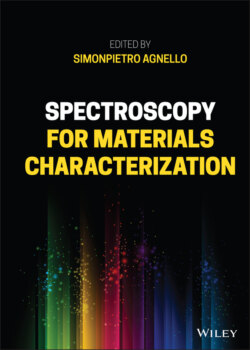Читать книгу Spectroscopy for Materials Characterization - Группа авторов - Страница 63
3.4.2 FLUC: Typical Experimental Setups
ОглавлениеA possible implementation of these concepts is reported in the bottom of Figure 3.5. Here, the gate wavelength is set at 800 nm, and the fluorescence is in the visible range, yielding an upconverted pulse in the near‐UV, as can be obtained from the SFG equation: ω PL + ω gate = ω up. Some technical upgrades allow to detect a fluorescence in the UV range (≈280 nm) [2, 42], which corresponds to generating and detecting the upconverted pulse in the deep‐UV (≈210 nm). While the excitation pulse intensity is limited by linearity requirements, the intensity of the gate beam cannot usually overcome 1 μJ per pulse because of practical reasons (e.g. BBO damage). Moreover, the thickness of the BBO is limited by time resolution requirements (e.g. limiting GVD in the SFG process), and the number of fluorescence photons participating in SFG process at any given delay is only a tiny portion of the total emission, because of the very short duration of the gate pulse (tens of femtoseconds vs. nanosecond lifetime). Thereby, the upconverted signal is in practice very weak, even as low as <1 upconverted photon per excitation pulse. FLUC thus requires great care in isolating this signal, which is achieved by a combination of spatial and spectral filtering methods, and finally directing to a highly sensitive detection system, such as a single photon counter or a highly sensitive CCD [2].
Figure 3.5 Scheme of a typical fluorescence upconversion setup.
Recording the upconverted pulse as a function of the gate delay allows to reconstruct the kinetics of the emission at a given wavelength, at variable delays from photoexcitation, with femtosecond time resolution. In particular, the temporal resolution of these experiments is ultimately determined, once detrimental effects are eliminated (e.g. GVM in the BBO), by the cross‐correlation between the pump and the gate, which can be as low as a few tens of femtoseconds. Notably, efficient SFG can only occur if the phase matching condition (Δk = 0) is fulfilled, which only occurs at a precise orientation of the nonlinear crystal. Thus, the simplest approach to FLUC is acquiring single‐wavelength fluorescence kinetics, as a function of excitation–gate delay, for a given crystal orientation. Rotating the nonlinear crystal changes the phase matching condition and allows to upconvert different spectral portions of the emission band. Then, repeating the measurement with different crystal positions allows to reconstruct the dynamics of the entire fluorescence band as a function of wavelength and time [45].
In Figure 3.5, the excitation beam is obtained by SHG of the fundamental Ti:sapphire beam, chopped, and finally focused on the sample by a parabolic mirror. After excitation of the sample, the spontaneous emission is collected and collimated by second parabolic mirror and, then, focused by a third parabolic mirror with the same diameter into the SFG crystal, where the delayed gate at 800 nm finally overlaps to the fluorescence spot. The setup uses a slightly noncollinear geometry to facilitate separation of the three beams after the nonlinear crystal, although the noncollinearity angle is kept very low in order to reduce GVM effects within the crystal, which would otherwise degrade time resolution. After the nonlinear crystal, the upconverted emission passes through a monochromator, and UV pass‐band filters, and is finally sent to a photomultiplier (PMT), the output of which is read by a lock‐in amplifier. In this configuration, the data are collected as single‐wavelength traces. The detected wavelength is determined by rotating the nonlinear crystal, thus, determining a certain phase matching angle. More sophisticated setups use broad wavelength detection, which is obtained by substituting the PMT with a CCD camera, and by performing a computer‐controlled rotation of the nonlinear crystal during data acquisition. By this method, the whole emitted spectrum can be acquired at any given delay [2, 42].
Interestingly, because of the phase matching condition, the SFG process is automatically polarization sensitive, meaning that only the fluorescence component that has the same polarization of the gate (type I phase matching) is upconverted in the BBO and detected by the setup. Therefore, by adding a waveplate in the pump arm, as in a TA experiment, the polarization of the latter can be controlled, and polarization‐sensitive measurements can be easily achieved by a setup such as in Figure 3.5. To achieve this aim, one repeats each measurement in the two pump polarizations, parallel (para) or perpendicular (ortho) to the gate, respectively, and calculates the fluorescence anisotropy r(t):
(3.18)
Femtosecond fluorescence anisotropy measurements often provide important information regarding the occurrence of random rotational diffusion within the system, or any other phenomena (e.g. energy transfer and site‐to‐site excitation migration) capable of randomizing the orientation of the electric dipoles [46].
The actual design of a FLUC setup involves a relatively complex optimization problem involving multiple geometrical parameters to find the best compromise between signal intensity, noise rejection, and time resolution. While this topic cannot be fully covered here, a significant example is given by the geometry of the telescope directing the fluorescence into the nonlinear crystal. In fact, the focal lengths of the two parabolic mirrors used in Figure 3.5 must be chosen in such a way that the fluorescence enters the BBO within the acceptance angle for the SFG process. If n o is the ordinary refractive index, and θ m is the phase matching angle, the SFG acceptance angle is given by [47]:
(3.19)
The need to fulfill this condition imposes relatively tight limitations on the possible geometrical parameters of a setup such as in Figure 3.5. Similar considerations can be done for many other relevant geometrical parameters, the optimization of which constitutes an important aspect in the design of any FLUC setup [47].
